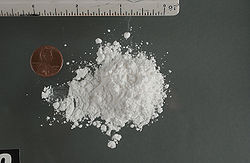Cocaine toxicity
Jump to navigation
Jump to search
Cocaine toxicity is seen in by pathologists in the forensic setting.
General
- Anatomical findings at autopsy are uncommon (most common situation) or non-specific (atherosclerosis +/- acute thrombosis).[1]
- Toxicity mechanisms:
- Direct effects of norepinephrine on myocytes
- Vasospasm leading to myocardial ischemia.
- Main metabolite (found in urine): benzoylecgonine.[2]
Gross pathology
Features (heart):[3]
- +/-Atherosclerosis out of keeping with age.
- +/-Large areas of confluent necrosis.
- +/-Fibrosis.
Microscopic
Features (heart):[3]
- +/-Large areas of confluent necrosis.
- +/-Contraction band necrosis.
- +/-Fibrosis.
- +/-Myocarditis (usu. eosinophilic).
See also
References
- ↑ Virmani R (1991). "Cocaine-associated cardiovascular disease: clinical and pathological aspects". NIDA Res. Monogr. 108: 220–9. PMID 1749414.
- ↑ Munoz, EM.; Lorenzo-Abalde, S.; González-Fernández, A.; Quintela, O.; Lopez-Rivadulla, M.; Riguera, R. (Jul 2011). "Direct surface plasmon resonance immunosensor for in situ detection of benzoylecgonine, the major cocaine metabolite.". Biosens Bioelectron 26 (11): 4423-8. doi:10.1016/j.bios.2011.04.056. PMID 21664118.
- ↑ 3.0 3.1 Kloner RA, Hale S, Alker K, Rezkalla S (February 1992). "The effects of acute and chronic cocaine use on the heart". Circulation 85 (2): 407–19. PMID 1346509. http://circ.ahajournals.org/cgi/pmidlookup?view=long&pmid=1346509.
